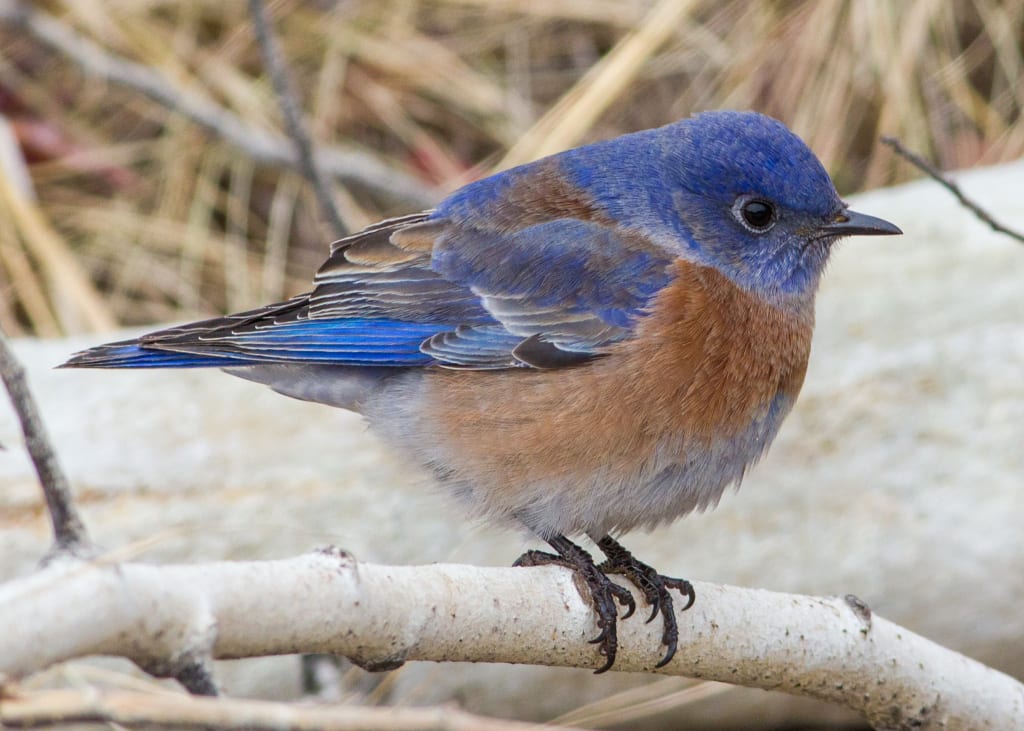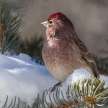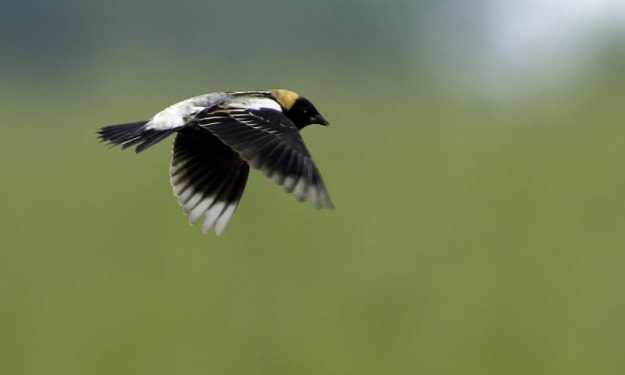
The western bluebird (Sialia mexicana) is around 15 to 18 cm long, a small thrush. Young males on top and bottom are bright blue with an orange breast and neck, a brownish patch on the back and covered with a grey belly and an undertail. Adult females have a more streamlined blue body, wings, and tail than males, a brown throat, a light orange breast, and a white belly and undertail. Immature western bluebirds, with bands on their front and back, have more deep colours than juveniles. These differences in colour appear to play a role in the mating cycle, as males compete for women's breeding rights. These are often mistaken for other bluebirds but can be easily recognised. The western bluebird has a green or blue throat, the eastern bluebird has a black throat, and the mountain bluebird is without an orange shade anywhere on its body. It's got a stocky structure with a long straight beak and a rather short tail. The posture is to perch upright and elevated perches on wire fences. The western bluebird pounces on the ground while seeking food, for example worms and berries. It often flies when engaged in catching aerial predators, such as insects. The western bluebird drinks water from nearby streams, and is commonly used in bird baths. The western bluebird was forced out of its natural habitat because of the cutting down of trees; however, the western bluebird has adapted to thrive coniferous forests, forest, semi-open deserts and desert. The year-round region includes the United States of California, the southern Rocky Mountains, Arizona, and New Mexico, as far south as the Oaxaca and Veracruz regions of Mexico. The summer breeding field stretches north up to Pacific Northwest, British Columbia and Montana. Northern birds may migrate to the southern portions of the range; southern birds often remain permanently. We nest in cavities or in nest boxes, with tree swallows, house sparrows and European starlings competing for natural breeding sites. Owing to the high degree of competition, House sparrows often harass western bluebirds for their nests. The attacks are conducted in groups, or independently. If the opening of the nesting box is kept to a diameter of 38 mm to avoid overtaking, starling attacks should be minimised. Nest boxes come into operation as the population is small and dies out due to the following threats: rats, raccoons, possums and pick game birds such as the hawk of the Cooper. Rats, bees, earwigs and wasps will crawl inside the nesting boxes and damage the newborns. Western bluebirds are breeding in treetop holes, or nesting boxes between birds. Their beaks are too low and too narrow to carve out their own holes, so to make their nest sites rely on woodpeckers. Western bluebirds are more able to successfully flee young in stable woodland than in wild environments, but are at greater risk of infestation by insects. The consequences of post-fledging recovery remain unclear. They were found to gain more success with nest boxes than in the usual cavities. They began to lay eggs early, had greater breeding success and lower predation rates, and fled in boxes younger than in cavities, but had no bigger egg clutches. In a good year the parents will rear two broods, with four to six eggs per clutch. According to genetic studies, 45 per cent of western bluebird nests included young people who were not descendants of male partners. Besides, they help their parents raise a new brood while their own nest is crumbling. Their calling is composed of greeting songs that sound like "cheer," "chur-chur," and "chup." This helps male western bluebirds to easily locate females in shortened "chweer" or "che-cheek" and notify males that they belong.
About the Creator
MB
I am a bird aficionado and really enjoy spotting them them on hikes. I greatly appreciate the variety of birds cross North America and the world. They are amazing and intelligent creatures, each so unique and with a wonderful life.






Comments
There are no comments for this story
Be the first to respond and start the conversation.